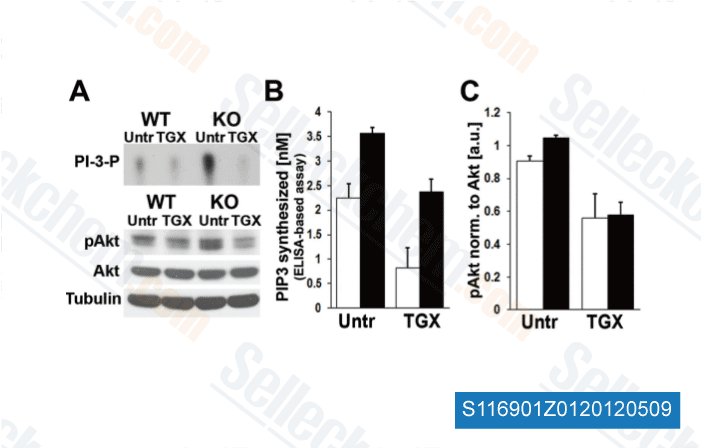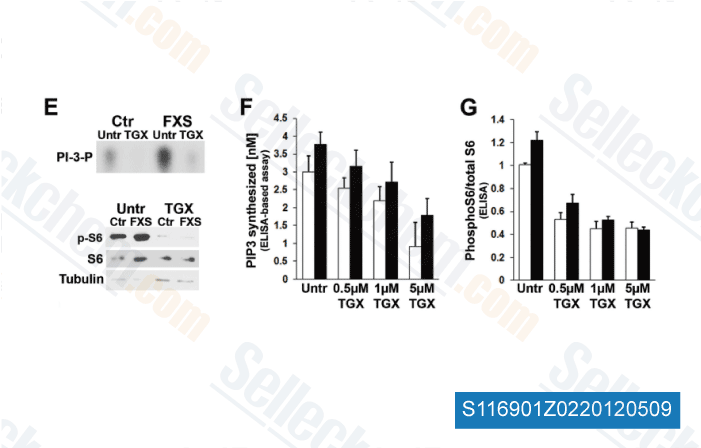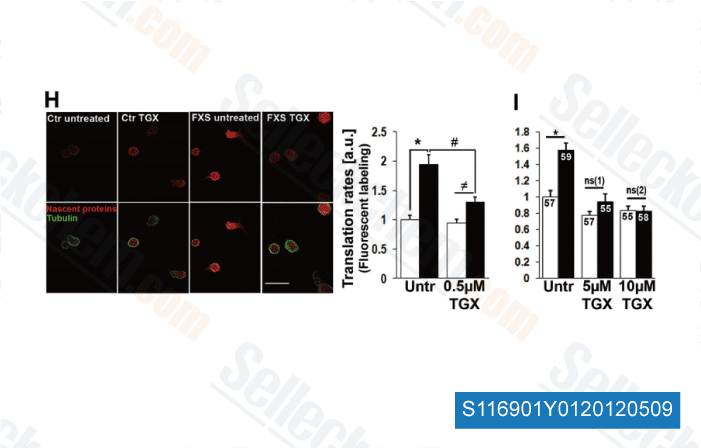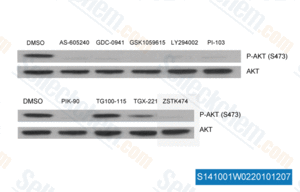|
Toll Free: (877) 796-6397 -- USA and Canada only -- |
Fax: +1-832-582-8590 Orders: +1-832-582-8158 |
Tech Support: +1-832-582-8158 Ext:3 Please provide your Order Number in the email. |
Technical Data
| Formula | C21H24N4O2 |
||||||
| Molecular Weight | 364.44 | CAS No. | 663619-89-4 | ||||
| Solubility (25°C)* | In vitro | DMSO | 50 mg/mL (137.19 mM) | ||||
| Water | Insoluble | ||||||
| Ethanol | Insoluble | ||||||
| In vivo (Add solvents to the product individually and in order) |
|
||||||
|
* <1 mg/ml means slightly soluble or insoluble. * Please note that Selleck tests the solubility of all compounds in-house, and the actual solubility may differ slightly from published values. This is normal and is due to slight batch-to-batch variations. * Room temperature shipping (Stability testing shows this product can be shipped without any cooling measures.) |
|||||||
Preparing Stock Solutions
Biological Activity
| Description | TGX-221 is a p110β-specific inhibitor with IC50 of 5 nM in a cell-free assay, 1000-fold more selective for p110β than p110α. | ||||
|---|---|---|---|---|---|
| Targets |
|
||||
| In vitro | The activity of TGX-221 against different isoforms is measured in an in vitro PI3K assay using multiple preparations of recombinant p85/p110. TGX-221 show slow potent to p110δ with IC50 of 211 nM. Furthermore, TGX-221 partially attenuates insulin-induced phosphorylation of Ser473 of PKB in J774.2 macrophage cells. [1] TGX-221 inhibits platelet-ECC interaction, platelet aggregation and platelet-granulocyte binding in an extracorporeal circulation (ECC) model. [2] A recent study shows that after treatment with TGX-221 (0.2, 2, and 20 μM), PC3 cells show inhibition of proliferation with a significant reduction of the activity of the p110β PI3K isoform. [3] | ||||
| In vivo | As an anti-thrombotic agent, TGX-221 at doses 1 + 1 (49 %) and 3+3 (88 %) improves integrated blood flow over 30 minutes in a mouse model. In addition, Tail bleeding time (BT) (sec) increases with TGX-221 doses of 3 + 3 (median 1560) and 1 + 1 (1305) and mean renal BT (sec) also increases in all TGX-221 groups. [4] |
Protocol (from reference)
| Kinase Assay:[1] |
|
|---|---|
| Cell Assay:[3] |
|
| Animal Study:[3] |
|
References
Customer Product Validation

-
Data from [Mol Med, 2012, 18, 336-45]

-
Data from [Mol Med, 2012, 18, 336-45]

-
Data from [Mol Med, 2012, 18, 336-45]

-
, , Saraswati Sukumar of Johns Hopkins University School of Medicine
Selleck's TGX-221 has been cited by 101 publications
| Integration of 3D bioprinting and multi-algorithm machine learning identified glioma susceptibilities and microenvironment characteristics [ Cell Discov, 2024, 10(1):39] | PubMed: 38594259 |
| Microglia degrade Alzheimer's amyloid-beta deposits extracellularly via digestive exophagy [ Cell Rep, 2024, 43(12):115052] | PubMed: 39644493 |
| WWP1 inhibition suppresses the proliferation of pancreatic cancer cells by regulating the PI3K-AKT pathway [ J Gastroenterol, 2024, 10.1007/s00535-024-02192-x] | PubMed: 39656237 |
| Machine learning-based identification of lower grade glioma stemness subtypes discriminates patient prognosis and drug response [ Comput Struct Biotechnol J, 2023, 21:3827-3840] | PubMed: 37560125 |
| Machine learning-based identification of lower grade glioma stemness subtypes discriminates patient prognosis and drug response [ Comput Struct Biotechnol J, 2023, 21:3827-3840] | PubMed: 37560125 |
| Pan-PI3K inhibition with copanlisib overcomes Treg- and M2-TAM-mediated immune suppression and promotes anti-tumor immune responses [ Clin Exp Med, 2023, 10.1007/s10238-023-01227-6] | PubMed: 37935952 |
| Overcoming resistance to immune checkpoint therapy in PTEN-null prostate cancer by intermittent anti-PI3Kα/β/δ treatment [ Nat Commun, 2022, 13(1):182] | PubMed: 35013322 |
| Long noncoding RNA-mediated activation of PROTOR1/PRR5-AKT signaling shunt downstream of PI3K in triple-negative breast cancer [ Proc Natl Acad Sci U S A, 2022, 119(43):e2203180119] | PubMed: 36269860 |
| Platelet p110β mediates platelet-leukocyte interaction and curtails bacterial dissemination in pneumococcal pneumonia [ Cell Rep, 2022, 41(6):111614] | PubMed: 36351402 |
| The Lectin LecB Induces Patches with Basolateral Characteristics at the Apical Membrane to Promote Pseudomonas aeruginosa Host Cell Invasion [ mBio, 2022, 13(3):e0081922] | PubMed: 35491830 |
RETURN POLICY
Selleck Chemical’s Unconditional Return Policy ensures a smooth online shopping experience for our customers. If you are in any way unsatisfied with your purchase, you may return any item(s) within 7 days of receiving it. In the event of product quality issues, either protocol related or product related problems, you may return any item(s) within 365 days from the original purchase date. Please follow the instructions below when returning products.
SHIPPING AND STORAGE
Selleck products are transported at room temperature. If you receive the product at room temperature, please rest assured, the Selleck Quality Inspection Department has conducted experiments to verify that the normal temperature placement of one month will not affect the biological activity of powder products. After collecting, please store the product according to the requirements described in the datasheet. Most Selleck products are stable under the recommended conditions.
NOT FOR HUMAN, VETERINARY DIAGNOSTIC OR THERAPEUTIC USE.
